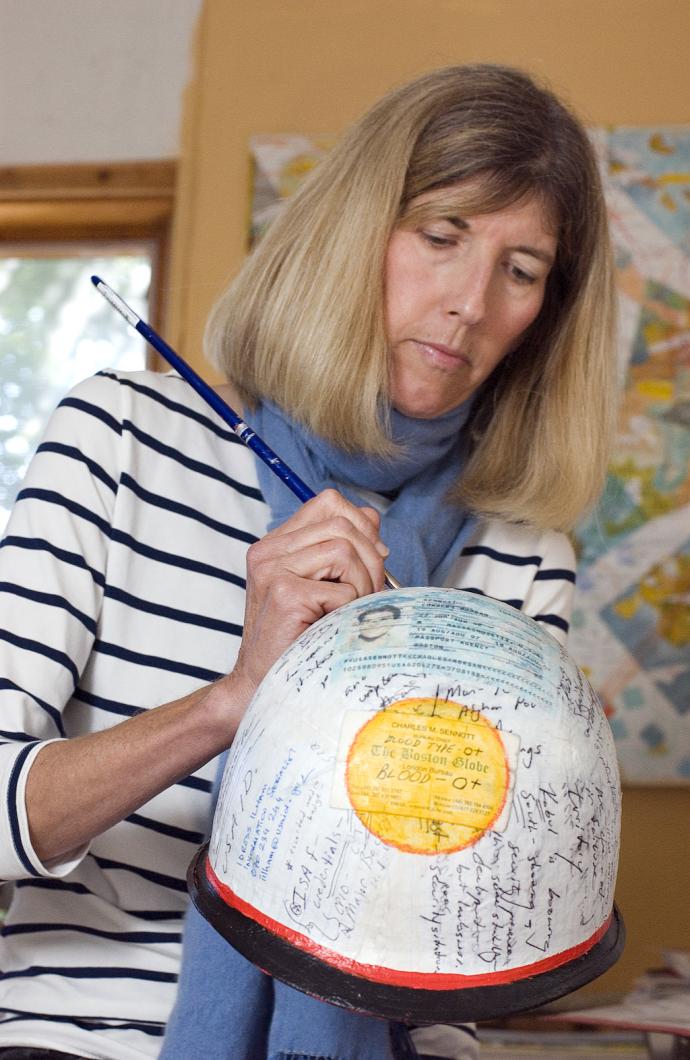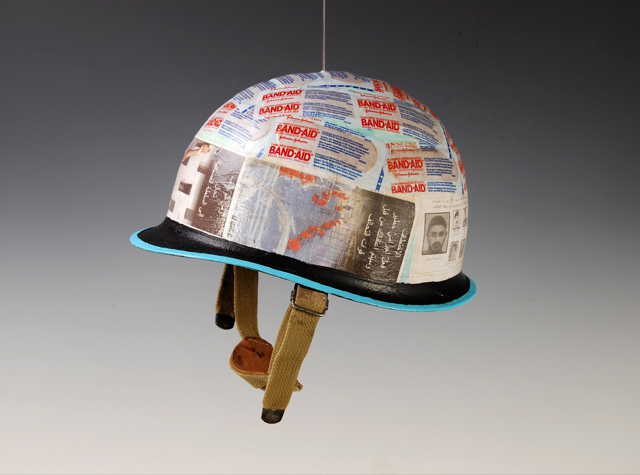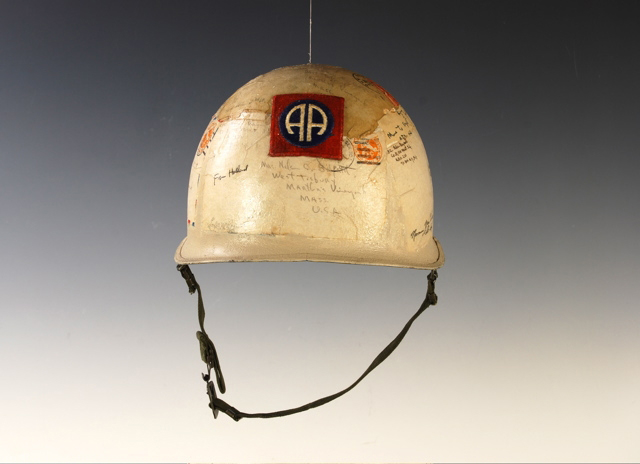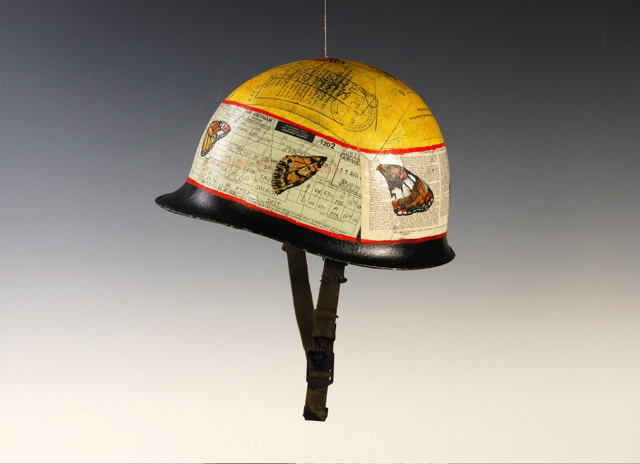War is a force that gives her meaning.
In her hands, Island artist Cindy Kane held the jacket of Chris Hedges’ book. She paused over its name. “War is a Force that Gives Us Meaning,” she said and shook her head. “I love that title.” She has read the book cover to cover. Mr. Hedges is a reporter she holds in the highest regard. Just a few days ago a package arrived in her mail; his name was listed in the return address. Inside the package was the book jacket, pages of notes from wars he has covered overseas and hate mail he has received over the years for his reporting on the atrocities of war.
Ms. Kane ruminated over the title, but put the cover back into its envelope. She pulled out a letter instead. It was clumsily handwritten on white, lined paper. It included accusations and names of all kinds. In one part, it read: “You are a putrescence.” With one fluid movement, Ms. Kane ripped the letter in two, then in half again and again until it was the size of a small rectangle. “I generally don’t read the notes at all,” she said as she held a piece against the curve of a steel military helmet. “You can’t get attached to them, then you can’t get them into the right shape.”
She talked distractedly as she tried to position the ripped paper onto the helmet, the latest in her installation project-in-progress which, when finished, will look like this: 50 original, used, steel military helmets hanging from the ceiling in a circle. The helmets are covered with the notes, the airline tickets, the Band-Aids, the photographs of 49 foreign correspondents, all of whom have seen war overseas. The 50th helmet is covered with mementos sent along by Jared Meader, Ms. Kane’s Vineyard Haven neighbor who is now on his second tour of duty in Iraq.
“After the death of Daniel Pearl, I found myself thinking about how to participate in the national pulse of grieving,” Ms. Kane said this week from her studio, a small attic space whose walls are covered with her art. The bookshelves are full of books on war, politics and current events. In this studio, what is not art is writing.
The death of Mr. Pearl, the American journalist who was kidnapped and murdered in Pakistan in 2002, was just one of the things that prompted Ms. Kane to begin this project. First and foremost was her family. “This is set against a backdrop of growing up with an activist mother who took us to every peace demonstration. When we were little, little kids she took us to sit-ins during the civil rights movement,” she said. Ms. Kane’s father is a former journalist and from an early age, the artist learned to revere the news and its writers. “I think of journalists as our modern day warriors,” she said.
Then there was her history of making art in reaction to war. In 2003, at the beginning of the Iraq War, Ms. Kane bought 40 blank slates and distributed them among Island artists. She asked each to paint, plaster, decorate the slate as they wished. When finished, she lined the slates up side by side and hung them at the Field Gallery in West Tisbury. She titled the work Artists Respond to War and sold the slates for $500 each. The proceeds — over $10,000 — went to OxFam. “You have to be careful that you don’t project a message or opinion. You want people to come away with a sense of the devastation of war,” she said. “I always felt challenged to be socially relevant in my work. It’s a challenge,” she continued. “It’s easy to be didactic.”
And of course there was her love and respect for writers and her desire to peek into the work they do. Last year, she completed a project called Mapping Writers in which she took the handwritten notes and manuscripts from Island writers Ward Just, Geraldine Brooks, Tony Horwitz, Rose Styron, Charlayne Hunter-Gault and Jules Feiffer and incorporated them into a series of paintings. The project also gave her a taste of working cooperatively. “I have worked alone my whole life, which I enjoy,” she said. “But, I found myself wanting to do something broader than my own self.”
With the death of Mr. Pearl, Ms. Kane found herself inspired to create again. “I’ve always been someone who was motivated more by sorrow than by beauty or joy,” she said. She knew she wanted to pay tribute to journalists who, like Mr. Pearl, risked their lives for their work. “These are the leading foreign journalists of our time and their lives are more in danger now because of the situation our president has put us in,” she said. And she knew she wanted to present the art as an installation. “I wanted to be able to walk into something and have the experience of being surrounded by it,” she explained.
She began by asking the writers she had previously worked with if they would contribute again. They said yes. Then she read all of their books. Honestly, she said, all of them (Mr. Just alone has written 15 novels, four story collections, two works of nonfiction and one play). When she finished their books, she read their acknowledgements and then contacted the writers they thanked, asking if they would also take part. Soon the mail began to arrive.
Nora Boustany, winner of the George Polk Award for her foreign news coverage, sent original poems she wrote overseas. Island resident Nelson Bryant sent letters he wrote to his mother from Normandy during the D-Day invasion; the envelopes have his West Tisbury address on them. Packages came from winners of the Pulitzer Prize, the Emmy Award, the Peabody Award. Envelopes arrived full of notes written during wars in Yugoslavia, Cuba, Iraq, Korea, Vietnam, Panama, Bosnia, Kosovo, across the Middle East. Reporters sent prayer beads, a cigarette carton, badges and passports.
So what to do with this paper trail of wars gone by and battles still being fought? “I wanted the notes to be supported by something, to stand as an icon,” Ms. Kane said. “But I wasn’t sure what that would be.” Originally, she thought of gladiator shields. But then, after a thrift store visit, she came away with the idea of helmets. She took to the Internet and began ordering used, steel helmets. They cost in the ballpark of $20 each, she said, plus plenty of shipping and handling.
Ms. Kane paints the helmets white, then covers them with what she has come to term the paper detritus of the writers. The first helmets she completed contained more of her own artistic touches — splashes of color, paintings of butterfly wings and eyes. “I was treating them more like precious relics at first,” she said. “Now they are more bare boned. I think less is more now.”
Each helmet is unique, each process emotional, but some stood out more than others. “Getting Chris Hedges was a turning point in the project. I have been following his work for many, many years,” she said. Working on Neal Conan’s helmet was difficult; there was a dent from a bullet at the front. And the photographs National Public Radio correspondent Ivan Watson sent of wounded children in Iraq stirred emotion. “That got me teary, working on this one,” she said. But the hardest to grapple with was the package sent by Asra Nomani, the Muslim journalist whose house Mr. Pearl was staying in at the time of his kidnapping. “She sent along the original e-mail exchange from when she was waiting to hear about Daniel Pearl’s death,” she said. “She also sent her journal from that time. I couldn’t bear to touch it, so I sent it back. That was the turning point. That was the most emotional,” she said.
The project is not yet done. Blank helmets sit in a corner of the studio and Ms. Kane is still waiting for two writers to agree to take part and for some to send in their notes. “The longest part is waiting for the material to get to me. That and researching the writers. This is the easy part,” she said as she readied Mr. Hedges’ hate mail for gluing to a helmet.
On Sept. 7, the Carol Craven Gallery in Vineyard Haven will host an opening reception for the partially completed project. This winter, six of the helmets will be part of a collaborative show in Los Angeles called War is a Way of Life. And in March, the entire exhibit will be on display in New York. The individual helmets are not for sale, but the installation as a whole is. “The power of it lies in its sense of community,” Ms. Kane said. “It feels like a community of journalists.”
For more information on the Helmet Project, visit cindykane.com or cravengallery.com/kane.html.











Comments
Comment policy »